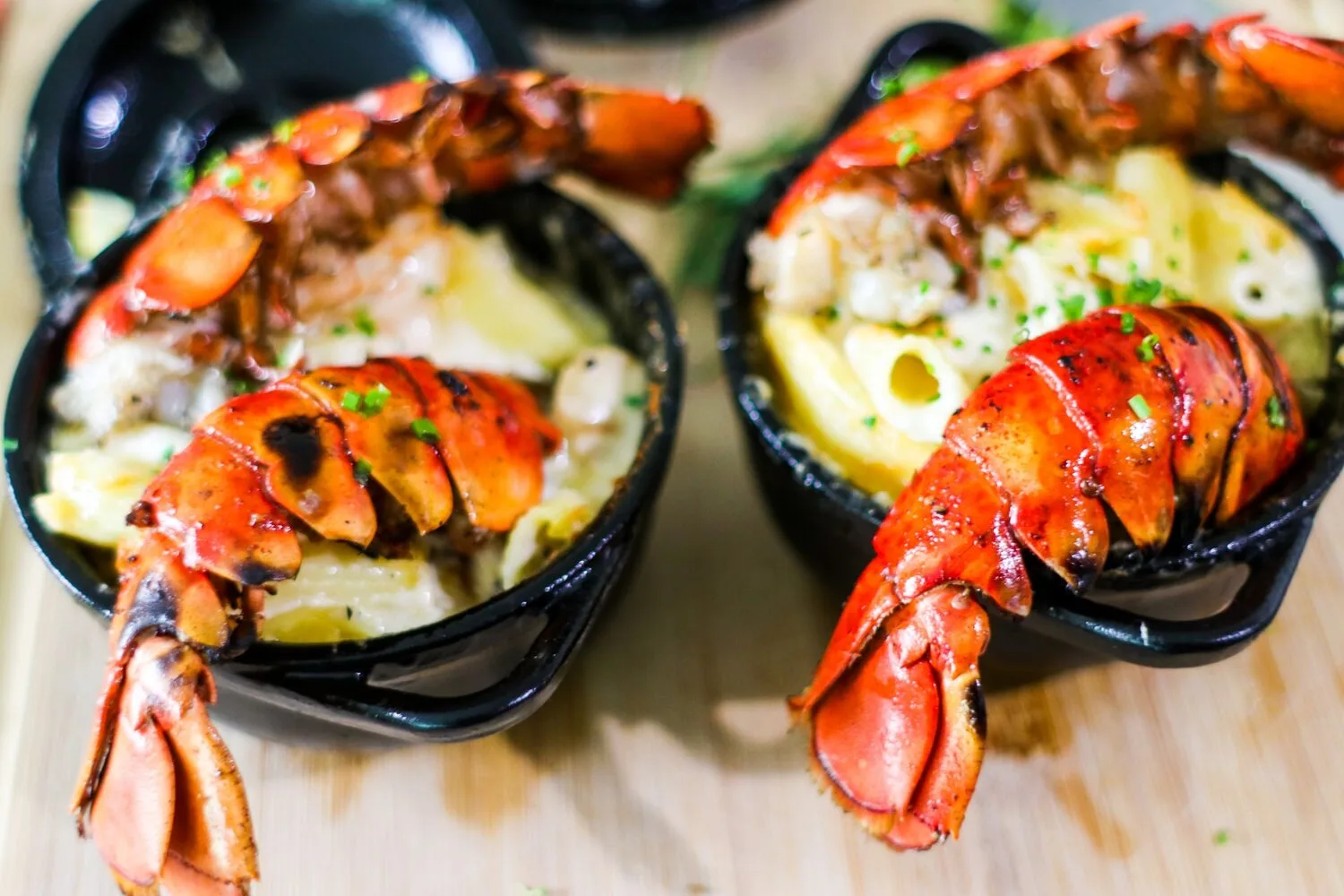If you’re trying to lose weight, let me tell you – incorporating more seafood into your diet can create a harmonious path towards hitting your health and fitness goals. As a nutrition coach, I’m constantly amazed by seafood’s powerful benefits for supporting weight loss. With its unique combo of lean protein, healthy fats, and essential nutrients, seafood is a true nutritional rockstar.
In this article, we’ll dive into picking the best seafood for weight loss, leveraging its nutritional prowess, utilizing it for appetite control and fat burning, and preparing it in diet-friendly ways. I’ll also share tips for enjoying seafood when dining out and discuss why sustainability matters. Get ready to make this conductor of nutritional excellence a bigger part of your healthy lifestyle orchestra!
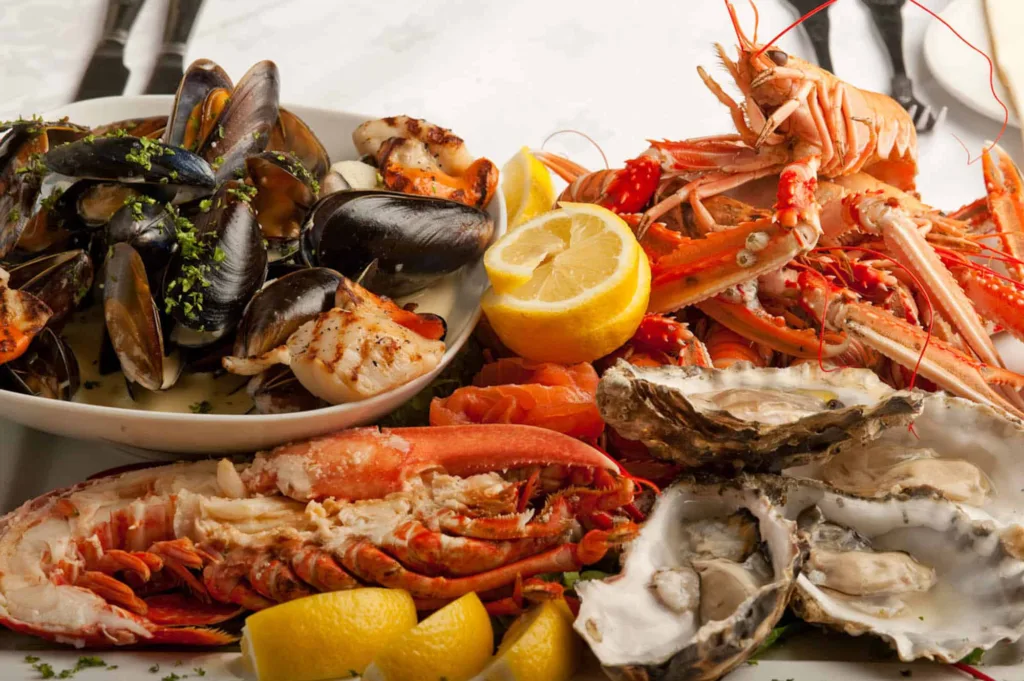
Selecting Seafood to Support Your Slim-Down
When it comes to choosing seafood to accelerate your weight loss, you have plenty of delicious options to pick from! Lean white fish like cod, haddock, sole, and flounder are all excellent low-calorie, high-protein choices. Shellfish including shrimp, lobster, clams, mussels, oysters, and scallops also deliver a hefty nutritional punch without too many calories.
Fatty fish like salmon and mackerel offer those beneficial omega-3s you’ve likely heard so much about. No matter which types you choose, be sure to get seafood that is fresh and of high quality whenever possible. The fresher the better, as seafood starts rapidly losing nutrients as soon as it’s caught or harvested.
Aim for wild caught or sustainably farmed seafood. While aquaculture has its controversies, well-managed farms can produce high quality seafood with less impact than wild harvesting. Just be wary of heavily processed imitation crab and fish sticks – they often contain questionable ingredients. When buying frozen or canned seafood, read labels closely and stick to reputable brands with simple, recognizable ingredients. With so many healthy and delicious options, there’s no reason you can’t find Multiple types of seafood that both aid your weight loss efforts and satisfy your palate!
Harnessing the Nutritional Horsepower of Seafood
When it comes to healthy eating for weight loss and overall wellness, seafood really is in a league of its own. Fatty fish varieties like salmon, mackerel, sardines, and herring are rich in omega-3 fatty acids, which have been shown to reduce inflammation, enhance heart health, and improve fat burning.
Research indicates omega-3s may also help promote feelings of fullness by positively influencing levels of appetite-regulating hormones like leptin. Most types of seafood are also excellent sources of high-quality, lean protein. Protein takes longer for the body to break down and digest compared to carbohydrates or fat. This results in you feeling more satisfied and content after eating protein-rich foods. Protein is also vital for building and maintaining calorie-burning lean muscle mass.
In addition to lean protein and anti-inflammatory omega-3 fats, seafood delivers an array of other nutrients beneficial for health and weight loss. Shellfish like oysters and mussels are loaded with zinc, a mineral important for immune function, metabolism, and wound healing. Many fish provide good amounts of vitamin D, which regulates hormones, strengthens bones, and may aid weight loss as well. Seafood is also one of the only natural sources of vitamin B12, critical for energy levels and red blood cell formation. With this unique symphony of essential nutrients, it’s easy to see why seafood can serve as a nutritional cornerstone of any healthy diet.
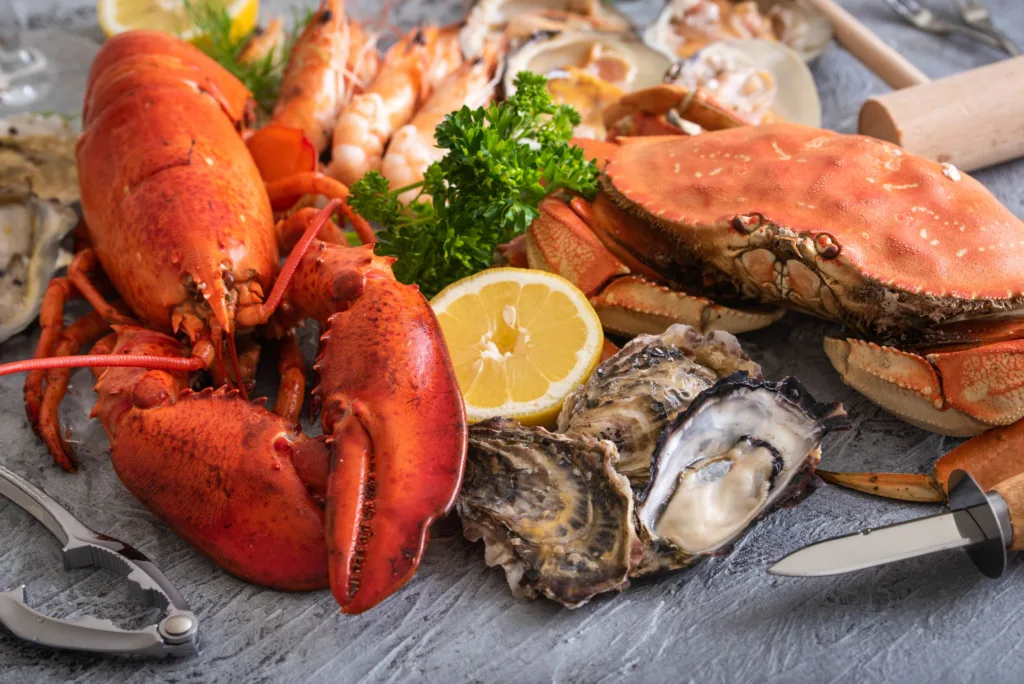
Leveraging Seafood for Effective Weight Management
It’s evident that seafood packs a serious nutritional punch, but how specifically can it help you shed excess pounds? For starters, the high protein content in most types of seafood assists with controlling hunger and appetite between meals. Protein is exceptionally filling and satisfying.
It takes more time and energy for the body to fully digest protein foods, leaving you feeling fuller longer after eating. Compare this to processed carbs and sugar that digest quickly, leading to spikes and crashes in blood sugar along with ravenous hunger shortly after eating. Substituting seafood for some meat in your diet helps reduce overall calorie intake without leaving you constantly hungry.
The abundance of omega-3 fatty acids in fatty fish may also help rev up metabolism and promote fat burning. Though research is ongoing, emerging evidence suggests the omega-3s in fish can boost fat loss, especially around the belly area. Some early studies show certain amino acids and minerals found abundantly in shellfish may inhibit digestion and absorption of carbohydrates and fats. Though more research is still needed, this could be another way seafood facilitates weight loss through reducing absorption of calories from food.
Beyond its direct metabolic and appetite-regulating effects, eating more seafood is also an easy way to displace less healthy foods from your diet. Swapping out fatty red meats for a serving of salmon or cod once or twice a week can trim overall calorie consumption without compromising nutrition. Choosing a grilled fish taco over fried foods eliminates empty calories and unhealthy fats. Simple substitutions like these really do add up, creating small steps towards big transformations on the scale and in your health!
Preparing Seafood for Maximum Nutrition
To fully reap the nutritional rewards seafood has to offer, it’s crucial to prepare it in a healthy way. Baking, broiling, poaching, steaming, and grilling are all excellent cooking methods that retain nutrients while avoiding excess calories and fat from frying. Consuming seafood raw, pickled, or cured (think sushi, ceviche, and smoked salmon) is also highly nutritious – just be sure it’s high quality and properly handled.
When seasoning seafood, emphasize fresh herbs, spices, citrus, garlic, shallots, and other low-calorie flavor enhancers rather than high-calorie sauces and dressings. Lemon pepper cod, Cajun shrimp, and ginger soy glazed salmon are all flavorful examples. Avoid unhealthy battering and frying which significantly boost calories and undermine seafood’s natural health benefits.
There are endless delicious, diet-friendly possibilities for creatively incorporating more seafood into your weight loss meal plan. Ceviche made with fresh raw fish, citrus, onions, and peppers is light, refreshing, and ultra lean. Blackened fish tacos on corn tortillas are tasty and slimming. Baked salmon alongside roasted veggies makes for a balanced, satisfying meal. Curries, stir fries, and noodle bowls with shrimp or scallops add variety without derailing your progress. Stuff mushrooms with crabmeat for an indulgent taste of luxury. The flavor potential is as vast as the sea once you dive into cooking with seafood.
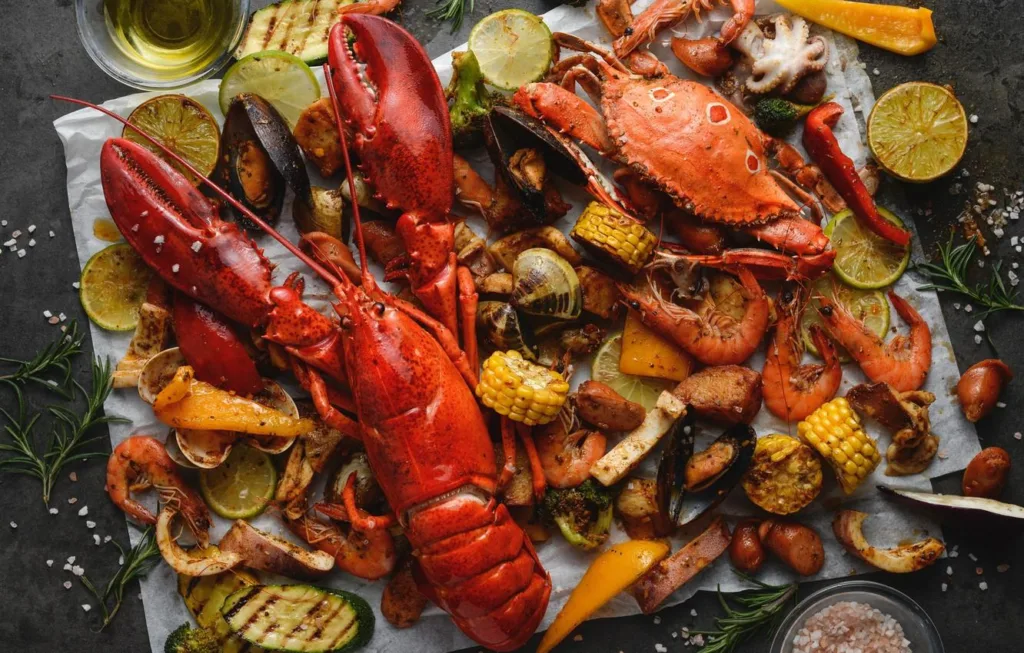
Incorporating Seafood Into a Balanced Diet
While seafood can certainly pull its nutritional weight for supporting weight control and fat loss, remember to consume it as part of an overall balanced diet. Lean proteins, whole grains, fruits, vegetables, nuts, seeds and healthy fats from other sources all play pivotal roles as well. Aim to fill at least half your plate at each meal with a colorful variety of non-starchy vegetables and fruits.
Choose minimally processed whole grains like brown rice, quinoa, farro and oats as your carbohydrate sources. Use healthy fats from olive oil, avocados, nuts, seeds and of course omega-3 rich fatty fish to round out meals. Creating a symphony of whole, nutrient-dense foods from all categories is key for optimal health, energy and sustainable weight loss over the long term.
While fatty fish delivers omega-3s, the American Heart Association recommends eating it just twice per week due to potential contaminants like mercury that accumulate in long-living fish. For variety, also regularly incorporate leaner white fish, shellfish, veggie proteins and plant sources of omega-3s from walnuts, chia and flaxseeds. A nutritiously balanced seafood centric diet is flexible and diverse, while packing a powerful punch for better health and weight management.
Mindful Eating with Seafood When Dining Out
You certainly don’t have to avoid restaurants completely when trying to lose weight. However, it’s extra important to be a mindful eater when dining out since it’s so easy to overindulge in this environment. When ordering seafood at restaurants, avoid anything that’s breaded, fried, or swimming in high-calorie creamy sauces. Grilled, baked, broiled and steamed preparations are far better options.
Request that sauces and dressings come on the side and use sparingly if at all. Ask for a double serving of vegetables instead of starchy sides like fries or rice pilaf. Feel free to order an appetizer portion or side salad as your main entrée to control portions. Request a to-go box when served and box up half the meal before digging in to keep portions in check. With a little planning and restraint, you really can enjoy both eating out and eating light.
Selecting Sustainable Seafood – It Matters!
In today’s era of modern industrial fishing and aquaculture, choosing sustainable seafood has become an increasingly important consideration for both human health and environmental reasons. Decades of overfishing and habitat destruction have left many wild fish populations depleted and marine ecosystems unbalanced.
However, avoiding seafood altogether fails to address these systemic problems. In fact, supporting responsible fisheries and fish farms through our purchases is critical for restoring balance to the oceans and securing bountiful and healthy seafood supplies for the future.
Do some research on major sustainable seafood guides that rate species based on abundance, catch methods, and farming practices. Monterey Bay’s Seafood Watch and the Marine Stewardship Council’s blue fish label are two excellent resources for making informed choices. While shopping or dining out, look for seafood certified as sustainable. Be willing to occasionally pay a bit more for responsibly farmed or caught seafood – it makes a difference! We can all be informed consumers and vote for sustainability with our hard-earned dollars.
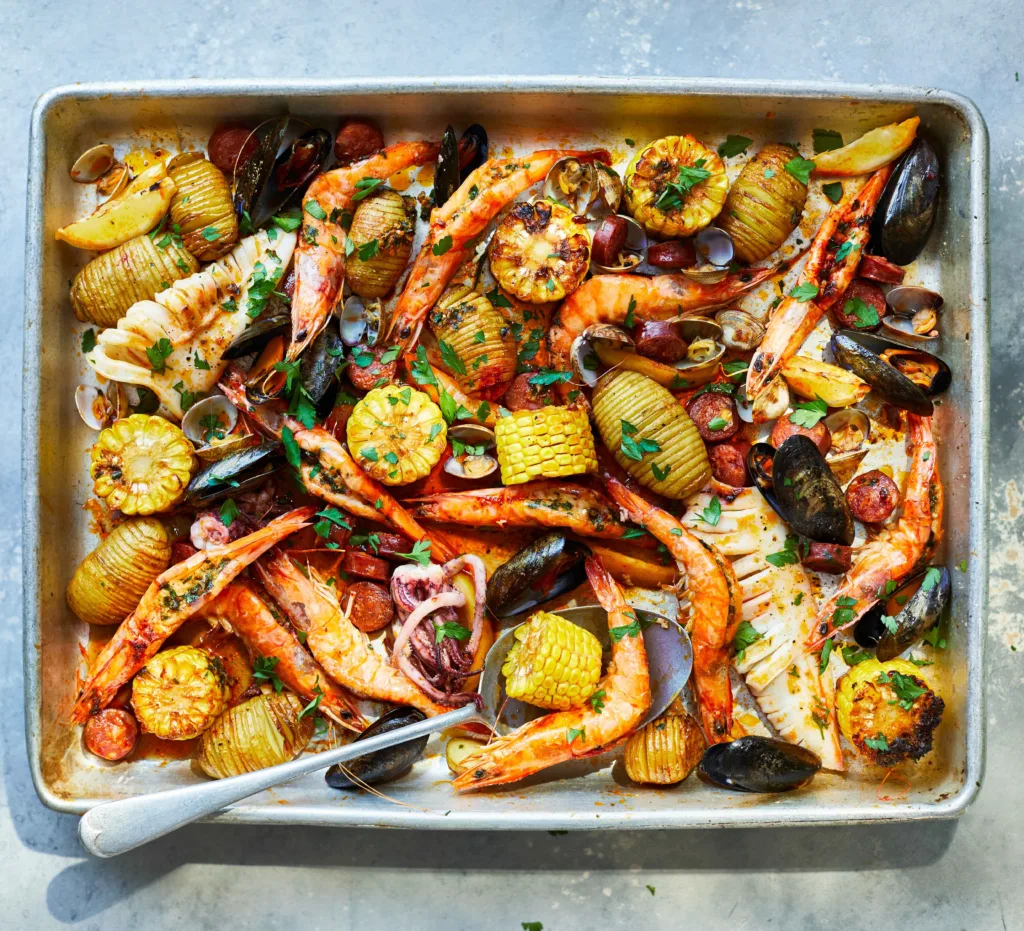
Final Thoughts on Seafood and Weight Loss
When it comes to achieving your health goals, making seafood a more prominent part of your diet can hit all the right notes. Seafood brings a multitude of unique benefits ranging from improving fat burning, reducing inflammation, optimizing hormone balance, and enhancing feelings of fullness after eating. It provides a means to cut calories without constant hunger pangs.
Seafood also allows you to displace less healthy foods for improved overall nutrition. Preparing seafood in diverse, flavorful, low-calorie ways expands your arsenal of healthy go-to meals. When enjoyed as part of a balanced diet of whole, nutritious foods, seafood can help orchestrate sustainable weight loss success. Make this nutritional rock star a bigger part of your healthy lifestyle!
I hope this provided you with helpful insights on leveraging seafood’s immense weight loss benefits. Be sure to sign up using the form below for my free newsletter containing health tips, recipes, workout ideas, wellness advice and so much more. I also invite you to explore my other in-depth nutrition articles on achieving your health goals and living actively. Now go enjoy a healthy, delicious seafood meal!
Thank you for reading this post, don't forget to subscribe to our free newsletter
!
